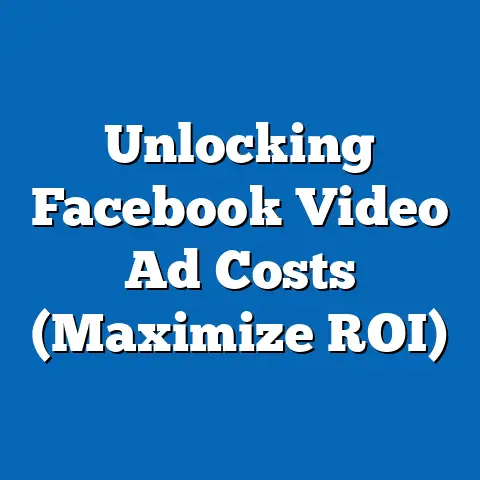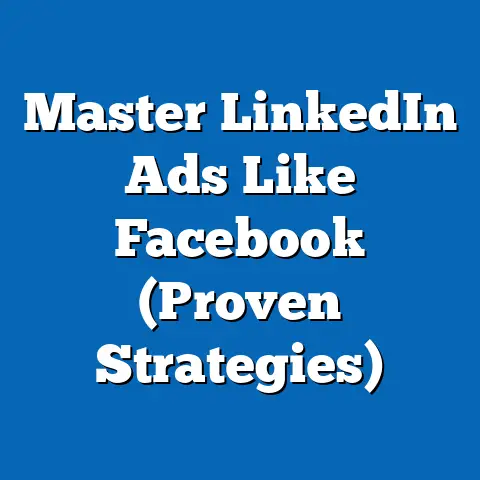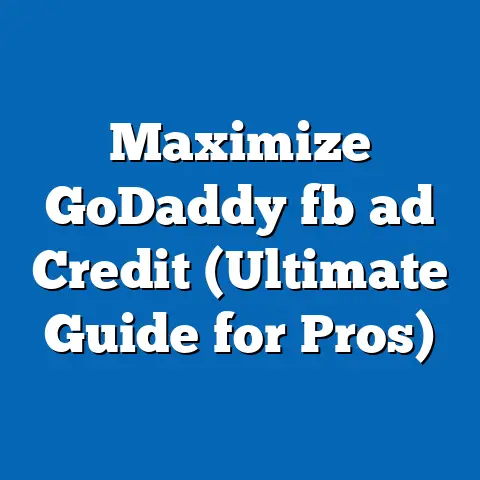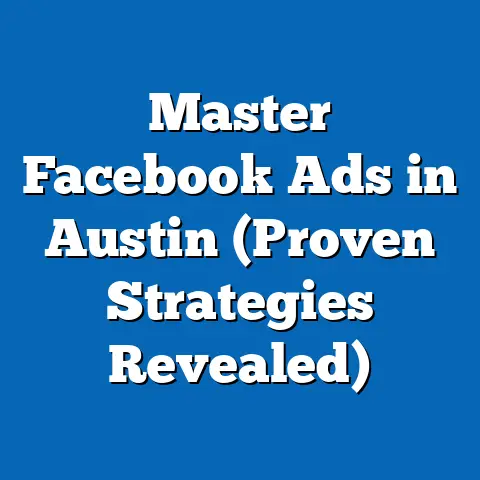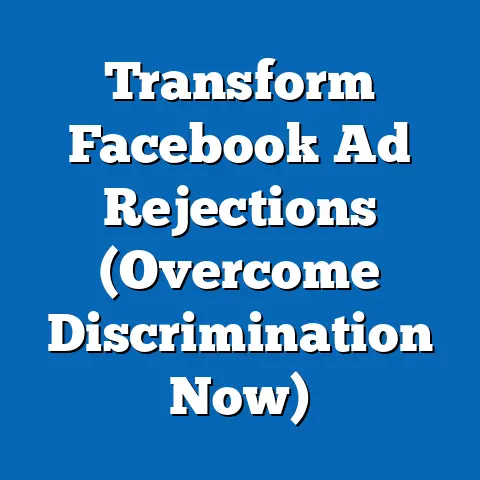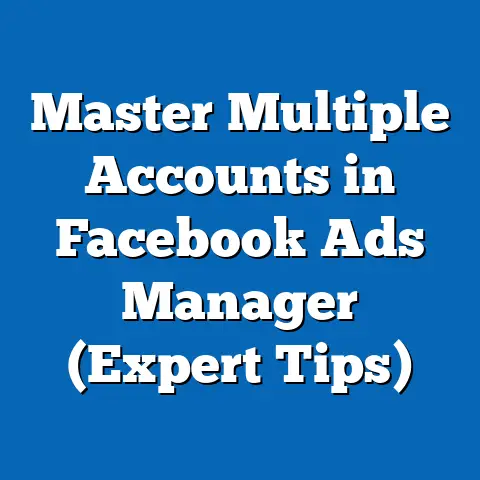5 Essentials for Crafting Phenomenal Facebook Ads (Game-Changer)
Just like our bodies need a balanced diet, regular exercise, and proper rest to thrive, so too does a business need a healthy marketing strategy to survive and grow. Think of your Facebook ads as the vitamins and workouts for your brand. A weak ad, like a sugary snack, might give you a temporary boost, but it won’t sustain long-term health. A phenomenal Facebook ad, on the other hand, is like a superfood smoothie packed with the nutrients your business needs to flourish.
I’ve seen countless businesses struggle, not because their product or service was bad, but because their advertising was ineffective. It’s like having a fantastic restaurant hidden down a back alley – nobody knows it’s there! That’s where Facebook ads come in. They’re the signposts, the aroma wafting down the street, drawing customers in to experience what you have to offer.
A well-crafted Facebook ad can be a game-changer. It can transform a struggling startup into a thriving enterprise, boost brand awareness, drive sales, and build a loyal customer base. But crafting those “phenomenal” ads isn’t just about luck; it’s about understanding the fundamentals and applying them strategically.
In this guide, I’m going to walk you through the five essentials that I’ve found, through years of experience and countless campaigns, are absolutely crucial for creating Facebook ads that not only get noticed but also deliver real results. We’ll cover everything from understanding your audience to analyzing your performance, giving you the tools and knowledge you need to transform your Facebook ads into a powerful engine for growth.
Here’s a sneak peek at what we’ll be diving into:
- Understanding Your Audience: Knowing who you’re talking to is the foundation of any successful ad campaign.
- Crafting Compelling Copy: Words matter! Learn how to write ad copy that grabs attention and drives action.
- Eye-Catching Visuals: A picture is worth a thousand words, but a great visual in your ad is worth a thousand clicks.
- Targeting and Retargeting Strategies: Reach the right people at the right time with laser-focused targeting.
- Analyzing and Optimizing Performance: Data is your friend. Learn how to track your results and make improvements.
So, are you ready to take your Facebook ads from “meh” to “phenomenal”? Let’s get started!
Section 1: Understanding Your Audience – The Foundation of Ad Success
Imagine trying to sell winter coats to people living in the tropics. Sounds ridiculous, right? Yet, that’s what many businesses do with their Facebook ads – they’re talking to the wrong people! Understanding your target audience is the bedrock of any successful advertising campaign, and it’s the first essential we’ll tackle.
Why is knowing your audience so crucial? Because it allows you to:
- Craft relevant messaging: When you understand your audience’s needs, desires, and pain points, you can create ad copy that speaks directly to them.
- Choose the right visuals: What appeals to a teenager might not appeal to a retiree. Knowing your audience helps you select visuals that resonate with them.
- Target your ads effectively: Facebook’s targeting options are incredibly powerful, but they’re only effective if you know who you want to reach.
- Improve your ROI: By targeting the right people with the right message, you’ll get more clicks, more conversions, and a better return on your investment.
Digging Deeper: Demographics, Interests, and Behaviors
So, how do you get to know your audience? Start by gathering data. Facebook provides a wealth of information about its users, and it’s your job to tap into it. Here are some key areas to explore:
- Demographics: This includes basic information like age, gender, location, education level, and job title.
- Interests: What are your audience’s hobbies, passions, and interests? What pages do they like on Facebook? What groups are they members of?
- Behaviors: What do your audience members do online? What purchases do they make? What devices do they use? What events do they attend?
Creating Audience Personas: Bringing Your Audience to Life
Once you’ve gathered data, it’s time to create audience personas. A persona is a fictional representation of your ideal customer, based on research and data. Personas help you humanize your audience and understand their motivations.
For example, let’s say you’re selling organic baby food. You might create a persona called “Sarah, the Health-Conscious Mom.” Sarah is 32 years old, lives in a suburban area, and has a 1-year-old child. She’s passionate about healthy eating and wants to provide her baby with the best possible nutrition. She spends time researching organic products and reading reviews online.
By creating this persona, you can start to understand Sarah’s needs and desires. You know that she’s looking for healthy, organic baby food that’s convenient and affordable. You can then craft ad copy that speaks directly to her, highlighting the benefits of your product and addressing her concerns.
Leveraging Facebook Audience Insights
Facebook Audience Insights is a powerful tool that allows you to gather data about your target audience. You can use it to explore demographics, interests, behaviors, and more.
To access Audience Insights, go to your Ads Manager and click on “Audience Insights” in the “Tools” menu. From there, you can select your target audience and start exploring the data.
I’ve found Audience Insights incredibly helpful for uncovering hidden interests and behaviors that I might not have considered otherwise. For example, I once used it to discover that my target audience for a fitness product was also interested in organic gardening. This led me to create ads that highlighted the connection between healthy eating and exercise, which resonated strongly with my audience.
The Power of Empathy: Connecting on a Personal Level
Ultimately, understanding your audience is about empathy. It’s about putting yourself in their shoes and understanding their needs, desires, and pain points. When you can connect with your audience on a personal level, you’ll be able to create ads that resonate with them and drive results.
I remember working with a local bakery that was struggling to attract new customers. After talking to their existing customers, I realized that they weren’t just selling bread and pastries; they were selling comfort, tradition, and a sense of community. We then crafted ads that highlighted these emotional benefits, and the bakery saw a significant increase in sales.
Key Takeaways for Understanding Your Audience:
- Knowing your target audience is the foundation of any successful ad campaign.
- Gather data about demographics, interests, and behaviors.
- Create audience personas to humanize your audience and understand their motivations.
- Leverage Facebook Audience Insights to uncover hidden insights.
- Emphasize empathy and connect with your audience on a personal level.
Next Steps:
- Identify your target audience for your Facebook ads.
- Gather data about their demographics, interests, and behaviors.
- Create audience personas to represent your ideal customers.
- Explore Facebook Audience Insights to uncover hidden insights.
- Start crafting ad copy and visuals that speak directly to your audience.
Section 2: Crafting Compelling Copy – Words That Convert
You’ve identified your target audience, now it’s time to talk to them! But not just any talk – you need to craft compelling copy that grabs their attention, sparks their interest, and ultimately drives them to take action. Think of your ad copy as the handshake that starts a relationship with a potential customer. A weak, uninspired handshake won’t make a good impression, but a firm, confident one will.
The Art of Persuasion: Clarity, Urgency, and Emotional Appeal
Effective ad copywriting is an art form that combines clarity, urgency, and emotional appeal. Let’s break down each of these elements:
- Clarity: Your ad copy should be easy to understand and get straight to the point. Avoid jargon, technical terms, and vague language. Tell your audience what you’re offering and why they should care.
- Urgency: Create a sense of urgency to encourage immediate action. Use phrases like “Limited Time Offer,” “Sale Ends Soon,” or “Don’t Miss Out.”
- Emotional Appeal: Connect with your audience on an emotional level by highlighting the benefits of your product or service. How will it make their lives better? How will it solve their problems?
The Power of a Strong Call-to-Action (CTA)
Your call-to-action (CTA) is the most important part of your ad copy. It tells your audience what you want them to do next. A strong CTA is clear, concise, and compelling.
Here are some examples of effective CTAs:
- “Shop Now”
- “Learn More”
- “Sign Up Today”
- “Get Started”
- “Download Now”
I’ve found that using action verbs and creating a sense of urgency can significantly improve CTA performance. For example, instead of saying “Learn More,” try “Discover the Secrets.” Instead of saying “Sign Up,” try “Claim Your Free Trial Now!”
Examples of High-Performing Ad Copy
Let’s look at some examples of high-performing ad copy from various industries:
- E-commerce: “Treat yourself to something special! Shop our latest collection of handcrafted jewelry and enjoy free shipping on orders over $50. Limited time offer – don’t miss out!”
- Software: “Tired of wasting time on tedious tasks? Our software automates your workflow and saves you hours every week. Try it free for 14 days and see the difference!”
- Local Business: “Craving authentic Italian cuisine? Visit [Restaurant Name] tonight and experience the taste of Italy. Mention this ad and get 10% off your entire bill!”
Notice how each of these examples combines clarity, urgency, and emotional appeal. They tell the audience what they’re offering, create a sense of urgency, and highlight the benefits of taking action.
A/B Testing Your Copy: Finding the Winning Words
One of the best ways to improve your ad copy is to A/B test different variations. A/B testing involves creating two or more versions of your ad copy and running them simultaneously to see which one performs better.
You can A/B test different headlines, body copy, CTAs, and even punctuation. The key is to only change one element at a time so you can accurately measure the impact of each change.
Facebook Ads Manager makes it easy to A/B test your ad copy. Simply create two or more ad variations and let Facebook’s algorithm do the rest. After a few days, you’ll be able to see which version is performing better and adjust your campaigns accordingly.
I once ran an A/B test on a Facebook ad for a local gym. One version of the ad copy used a straightforward approach, highlighting the gym’s amenities and pricing. The other version focused on the emotional benefits of joining the gym, such as improved health, increased confidence, and a sense of community. The emotional version outperformed the straightforward version by over 300%! This taught me the importance of connecting with my audience on an emotional level, even when selling something as practical as a gym membership.
Analyzing Performance Metrics: Tracking Your Success
Once you’ve launched your ad campaigns, it’s important to track your performance metrics to see how your ad copy is performing. Key metrics to track include:
- Click-Through Rate (CTR): This is the percentage of people who see your ad and click on it. A high CTR indicates that your ad copy is engaging and relevant.
- Conversion Rate: This is the percentage of people who click on your ad and then take the desired action, such as making a purchase or signing up for a newsletter. A high conversion rate indicates that your ad copy is effectively driving results.
- Cost Per Click (CPC): This is the amount you pay each time someone clicks on your ad. A low CPC indicates that your ad copy is effectively targeting the right audience.
By tracking these metrics, you can identify areas for improvement and refine your ad copy to maximize performance.
Key Takeaways for Crafting Compelling Copy:
- Clarity, urgency, and emotional appeal are essential elements of effective ad copywriting.
- A strong call-to-action (CTA) is crucial for driving results.
- A/B test different variations of your ad copy to find the winning words.
- Track your performance metrics to see how your ad copy is performing.
Next Steps:
- Review your existing Facebook ad copy and identify areas for improvement.
- Experiment with different headlines, body copy, and CTAs.
- A/B test different variations of your ad copy to see which one performs better.
- Track your performance metrics to see how your ad copy is performing.
- Continuously refine your ad copy based on performance data.
Section 3: Eye-Catching Visuals – Stopping the Scroll
In the fast-paced world of social media, your ad has to grab attention instantly. And what’s the fastest way to do that? With eye-catching visuals! Think of your visuals as the bait on a fishing hook. If the bait looks appealing, the fish (your potential customer) will be more likely to bite.
The Critical Role of Visuals: Enhancing Your Message
Visuals aren’t just pretty pictures; they’re a crucial part of your ad’s message. They can:
- Grab attention: A striking visual can stop people in their tracks as they scroll through their newsfeed.
- Communicate quickly: Visuals can convey complex information in a matter of seconds.
- Evoke emotions: Visuals can trigger emotions that resonate with your audience.
- Reinforce your brand: Visuals can help you build brand recognition and create a consistent brand identity.
Different Types of Visuals: Choosing the Right Format
Facebook offers a variety of visual formats for your ads, including:
- Images: Still images are a classic choice for Facebook ads. They’re easy to create and can be very effective if used well.
- Videos: Videos are more engaging than images and can be used to tell a story, demonstrate a product, or share a testimonial.
- Carousel Ads: Carousel ads allow you to showcase multiple images or videos in a single ad. This is a great option for showcasing a range of products or highlighting different features of a single product.
- Infographics: Infographics are a visual way to present data and information. They can be particularly effective for B2B advertising or for promoting complex topics.
I’ve found that video ads tend to perform best in terms of engagement, but image ads can be just as effective if they’re high-quality and relevant. Carousel ads are great for showcasing a variety of products or features, while infographics are ideal for presenting data-driven content.
Design Tips for Visually Appealing Ads
Creating visually appealing ads is an art form, but here are a few basic design tips to keep in mind:
- Use high-quality images and videos: Avoid blurry, pixelated, or poorly lit visuals.
- Choose visuals that are relevant to your ad copy: Your visuals should complement your ad copy and reinforce your message.
- Use color psychology to your advantage: Different colors evoke different emotions. Choose colors that are appropriate for your brand and your message.
- Keep it simple: Avoid clutter and distractions. Your visuals should be clean, clear, and easy to understand.
- Use text sparingly: Don’t overcrowd your visuals with text. Use text to highlight key points and direct attention.
- Optimize for mobile: Most Facebook users access the platform on their mobile devices. Make sure your visuals are optimized for mobile viewing.
Tools and Resources for Designing Ads
You don’t need to be a professional designer to create visually appealing ads. There are a number of tools and resources available that can help, including:
- Canva: Canva is a free online design tool that offers a wide range of templates and design elements.
- Adobe Spark: Adobe Spark is another online design tool that’s similar to Canva.
- Unsplash: Unsplash is a website that offers free, high-quality stock photos.
- Pexels: Pexels is another website that offers free stock photos and videos.
I personally use Canva for most of my Facebook ad design. It’s easy to use, affordable, and offers a wide range of templates and design elements.
Examples of Visually Striking Ads
Let’s look at some examples of visually striking ads that have successfully captured audience attention:
- Nike: Nike is known for its powerful, inspiring visuals that showcase athletes pushing their limits.
- Airbnb: Airbnb uses beautiful, inviting photos of homes and apartments around the world to entice travelers to book a stay.
- Dove: Dove’s “Real Beauty” campaign uses authentic, unretouched photos of women to promote body positivity.
These examples demonstrate the power of visuals to capture attention, evoke emotions, and reinforce brand values.
Key Takeaways for Eye-Catching Visuals:
- Visuals are a crucial part of your ad’s message.
- Choose the right visual format for your ad.
- Use high-quality images and videos.
- Follow basic design principles to create visually appealing ads.
- Use color psychology to your advantage.
- Optimize your visuals for mobile viewing.
- Use tools and resources like Canva and Unsplash to create professional-looking ads.
Next Steps:
- Review your existing Facebook ad visuals and identify areas for improvement.
- Experiment with different visual formats.
- Use high-quality images and videos.
- Follow basic design principles to create visually appealing ads.
- Optimize your visuals for mobile viewing.
- Use tools and resources like Canva and Unsplash to create professional-looking ads.
Section 4: Targeting and Retargeting Strategies – Reaching the Right People at the Right Time
You’ve got compelling copy and eye-catching visuals, but if you’re showing your ads to the wrong people, you’re wasting your time and money. That’s where targeting and retargeting come in. Think of targeting as aiming your arrow at the right target. Retargeting, on the other hand, is like giving your arrow a second chance to hit the bullseye.
The Power of Facebook’s Targeting Options
Facebook’s targeting options are incredibly powerful, allowing you to reach specific groups of people based on their demographics, interests, behaviors, and more. This allows you to create highly relevant ads that resonate with your target audience.
Here are some of the targeting options available on Facebook:
- Demographic Targeting: This allows you to target people based on their age, gender, location, education level, and job title.
- Interest-Based Targeting: This allows you to target people based on their interests, hobbies, and passions.
- Behavioral Targeting: This allows you to target people based on their online behavior, such as the websites they visit, the purchases they make, and the events they attend.
- Custom Audiences: This allows you to target people who have already interacted with your business, such as website visitors, email subscribers, or customers.
- Lookalike Audiences: This allows you to target people who are similar to your existing customers.
I’ve found that combining different targeting options can be particularly effective. For example, you could target women aged 25-35 who are interested in fitness and have recently purchased workout clothes online.
Custom Audiences: Targeting Your Existing Customers
Custom audiences are a powerful way to target people who have already interacted with your business. You can create custom audiences based on:
- Website Visitors: Target people who have visited your website.
- Email Subscribers: Target people who have subscribed to your email list.
- Customers: Target people who have purchased products or services from your business.
- App Users: Target people who have downloaded and used your mobile app.
- Facebook Page Engagers: Target people who have interacted with your Facebook page.
I’ve found that targeting website visitors and email subscribers is particularly effective. These people are already familiar with your brand and are more likely to convert.
Lookalike Audiences: Expanding Your Reach
Lookalike audiences allow you to target people who are similar to your existing customers. Facebook uses its algorithm to identify people who share similar demographics, interests, and behaviors with your existing customers.
This is a great way to expand your reach and find new customers who are likely to be interested in your products or services.
Retargeting: Giving Your Ads a Second Chance
Retargeting involves showing ads to people who have already interacted with your business but haven’t yet converted. This is a highly effective strategy because these people are already familiar with your brand and are more likely to take action.
For example, you could retarget people who have visited your website but haven’t added anything to their cart. You could show them ads featuring the products they were viewing, along with a special discount or offer.
Creating Effective Retargeting Campaigns
Here are some tips for creating effective retargeting campaigns:
- Segment your audience: Segment your retargeting audience based on their behavior. For example, you could create separate retargeting campaigns for website visitors, email subscribers, and customers.
- Personalize your ads: Personalize your ads based on the person’s previous interactions with your business. For example, you could show them ads featuring the products they were viewing on your website.
- Offer a special incentive: Offer a special discount or offer to encourage them to convert.
- Set a frequency cap: Don’t bombard people with too many ads. Set a frequency cap to limit the number of times they see your ads.
- Test different ad creatives: A/B test different ad creatives to see which ones perform best.
I once ran a retargeting campaign for an online clothing store that targeted people who had added items to their cart but hadn’t completed their purchase. We showed them ads featuring the items they had added to their cart, along with a 10% discount. This campaign resulted in a 20% increase in sales!
Key Takeaways for Targeting and Retargeting Strategies:
- Facebook’s targeting options are incredibly powerful.
- Use demographic, interest-based, and behavioral targeting to reach specific groups of people.
- Create custom audiences to target people who have already interacted with your business.
- Use lookalike audiences to expand your reach and find new customers.
- Retargeting is a highly effective strategy for driving conversions.
- Segment your audience, personalize your ads, and offer a special incentive.
Next Steps:
- Identify your target audience for your Facebook ads.
- Explore Facebook’s targeting options and create targeted ad sets.
- Create custom audiences based on your website visitors, email subscribers, and customers.
- Create lookalike audiences to expand your reach.
- Set up retargeting campaigns to target people who have already interacted with your business.
- Segment your audience, personalize your ads, and offer a special incentive.
Section 5: Analyzing and Optimizing Performance – Turning Data into Dollars
You’ve launched your Facebook ad campaigns, but your work isn’t done yet. Now it’s time to analyze your performance and optimize your campaigns for maximum ROI. Think of this as checking your business’s vital signs. You need to monitor key metrics to ensure your ads are healthy and performing optimally.
The Importance of Analytics: Understanding Your ROI
Analytics are essential for understanding how your ad campaigns are performing and whether you’re getting a good return on your investment (ROI). By tracking key metrics, you can identify areas for improvement and make adjustments to your campaigns to maximize performance.
Key Metrics to Track
Here are some key metrics to track in Facebook Ads Manager:
- Impressions: The number of times your ad was shown.
- Reach: The number of unique people who saw your ad.
- Click-Through Rate (CTR): The percentage of people who saw your ad and clicked on it.
- Cost Per Click (CPC): The amount you pay each time someone clicks on your ad.
- Conversion Rate: The percentage of people who clicked on your ad and then took the desired action, such as making a purchase or signing up for a newsletter.
- Cost Per Acquisition (CPA): The amount you pay to acquire a new customer.
- Return on Ad Spend (ROAS): The amount of revenue you generate for every dollar you spend on advertising.
I’ve found that tracking these metrics on a regular basis is essential for optimizing my Facebook ad campaigns. By monitoring these metrics, I can identify areas where my campaigns are performing well and areas where they need improvement.
Using Facebook Ads Manager to Analyze Campaign Performance
Facebook Ads Manager provides a wealth of data about your campaign performance. You can use it to track your key metrics, analyze your audience demographics, and see which ad creatives are performing best.
To access Facebook Ads Manager, go to your Facebook page and click on “Ad Center” in the left-hand menu. From there, you can view your campaign performance data and make adjustments to your campaigns.
Actionable Tips for Optimizing Your Ads
Here are some actionable tips for optimizing your Facebook ads based on performance data:
- Adjust Your Budgets: If your campaigns are performing well, consider increasing your budgets to reach more people. If your campaigns are performing poorly, consider decreasing your budgets or pausing them altogether.
- Refine Your Targeting: If your ads aren’t reaching the right people, refine your targeting options. Experiment with different demographics, interests, and behaviors to find the audience that’s most likely to convert.
- Modify Your Ad Creatives: If your ad creatives aren’t performing well, try changing them up. Experiment with different headlines, body copy, visuals, and CTAs to see what resonates best with your audience.
- A/B Test Your Ads: A/B testing involves creating two or more versions of your ad and running them simultaneously to see which one performs better. This is a great way to test different headlines, body copy, visuals, and CTAs.
- Use Retargeting: Retargeting involves showing ads to people who have already interacted with your business but haven’t yet converted. This is a highly effective strategy because these people are already familiar with your brand and are more likely to take action.
I once worked with a client who was struggling to get a good ROI from their Facebook ad campaigns. After analyzing their campaign performance data, I realized that they were targeting too broad of an audience and their ad creatives weren’t resonating with their target audience. We refined their targeting options, created new ad creatives, and implemented a retargeting campaign. Within a few weeks, their ROI had increased by over 200%!
Continuous Learning: Staying Updated with Facebook’s Evolving Ad Features
Facebook’s advertising platform is constantly evolving. New features, tools, and best practices are being introduced all the time. It’s important to stay updated with these changes so you can continue to optimize your campaigns for maximum performance.
Here are some ways to stay updated with Facebook’s evolving ad features:
- Read the Facebook Ads Blog: The Facebook Ads Blog is a great resource for learning about new features, tools, and best practices.
- Attend Facebook Webinars: Facebook regularly hosts webinars on various advertising topics.
- Join Facebook Advertising Groups: There are many Facebook advertising groups where you can connect with other advertisers and learn from their experiences.
- Experiment with New Features: Don’t be afraid to experiment with new features and tools as they’re released. This is the best way to learn how they work and how they can benefit your campaigns.
Key Takeaways for Analyzing and Optimizing Performance:
- Analytics are essential for understanding your ROI.
- Track key metrics such as impressions, reach, CTR, CPC, conversion rate, CPA, and ROAS.
- Use Facebook Ads Manager to analyze campaign performance.
- Adjust your budgets, refine your targeting, and modify your ad creatives based on performance data.
- A/B test your ads to see which ones perform best.
- Use retargeting to target people who have already interacted with your business.
- Stay updated with Facebook’s evolving ad features.
Next Steps:
- Set up tracking for your key metrics.
- Regularly analyze your campaign performance data in Facebook Ads Manager.
- Adjust your budgets, refine your targeting, and modify your ad creatives based on performance data.
- A/B test your ads to see which ones perform best.
- Use retargeting to target people who have already interacted with your business.
- Stay updated with Facebook’s evolving ad features.
Conclusion: Your Journey to Phenomenal Facebook Ads Starts Now
We’ve reached the end of our journey through the five essentials for crafting phenomenal Facebook ads. Let’s recap what we’ve covered:
- Understanding Your Audience: Knowing who you’re talking to is the foundation of any successful ad campaign.
- Crafting Compelling Copy: Words matter! Learn how to write ad copy that grabs attention and drives action.
- Eye-Catching Visuals: A picture is worth a thousand words, but a great visual in your ad is worth a thousand clicks.
- Targeting and Retargeting Strategies: Reach the right people at the right time with laser-focused targeting.
- Analyzing and Optimizing Performance: Data is your friend. Learn how to track your results and make improvements.
Mastering these five essentials can lead to transformative results for your business. It’s like giving your business a complete health makeover, improving its overall vitality and longevity in the marketplace.
Just like maintaining physical health requires consistent effort and attention, so too does creating phenomenal Facebook ads. It’s not a one-time fix, but an ongoing process of learning, experimenting, and optimizing.
So, I encourage you to take what you’ve learned in this guide and start implementing these strategies in your own Facebook ad campaigns. Don’t be afraid to experiment, to try new things, and to learn from your mistakes.
Watch as your Facebook ads become game-changers for your brand, driving more traffic, generating more leads, and ultimately boosting your bottom line. Your business’s health depends on it! Now go out there and create some phenomenal Facebook ads! You’ve got this!

